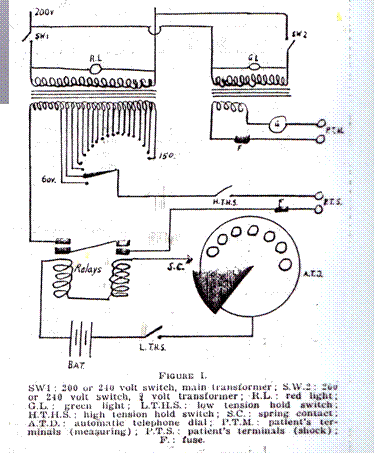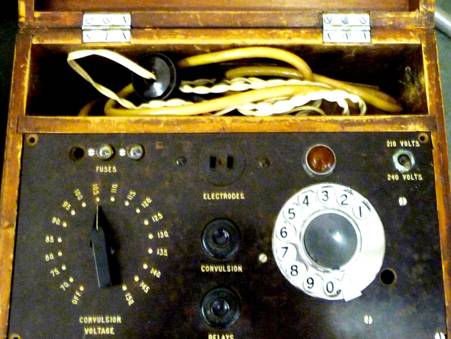
South Australian Medical Heritage Society Inc
Website for the Virtual Museum
Home
Coming meetings
Past meetings
About the Society
Main Galleries
Medicine
Surgery
Anaesthesia
X-rays
Hospitals,other organisations
Individuals of note
Small Galleries
Ethnic medicine
- Aboriginal
- Chinese
- Mediterran
Electroconvulsive therapy (ECT)
The South Australian experience
This report was stimulated by a publication by Dr.H.M. Birch, who published his experience with ECT therapy in the Medical Journal of Australia (MJA) in June 20 1942. He designed and constructed his own ECT apparatus, considered the first in Australia, described the physics involved and reported the clinical results.
An additional stimulus is the unique chronological collection of ECT machines since the 1940s stored in the Glenside Historical Museum, now part of the Film Corporation Campus. It is very important that these historic items be preserved
ACKNOWLEDGEMENTS: We are grateful to David Buob and Rob Adams from the Glenside Historical Society, who allowed us to photograph the old and more recent ECT machines in the then Glenside Museum and Bronwyn Scott, member of the ECT team, who showed us a recent ECT machine.
Before the introduction of psycho-trophic drugs (amitryptyline chlorpromazine etc.) the treatment of mental disorders relied on the use of heavy sedation to manage mania and excitement, typically with drugs such were such as paraldehyde and phenobarbitone. To manage self-harming and aggressive behaviour restraining jackets (more commonly known as straight jackets) were also used. Other devices such as mittens, hand muffs.and hobbles were used.
In the 1930s the pressure to find a cure in the face of increasing numbers of mentally ill and the resultant overcrowding typical of such institutions stimulated attempts to use more radical treatments such as insulin coma therapy in the 1930s or production of convulsions through the use of Cardiazole. The use of Insulin to produce coma through hypoglycemia was pioneered by Manfred Sakel, a Viennese psychiatrist in 1933. It involved intravenous insulin injection of 100-150 units. In 1934 L.J.Mecuna started to use Cardiazole to produce convulsions. It became popular for a short time but effects were unpredictable and occasionally complicated by fractures or joint dislocations.
In 1937 an Italian Professor of Neuropsychiatry Ugo Cerletti and his coworker Lucio Bini, started to use electroconvulsive therapy. Cerletti noticed that abattoirs pigs were rendered unconscious by electrocution before slaughter. If for some reason the killing was delayed and pigs recovered consciousness, they became quite docile. The method became popular and became adopted in the UK, Europe and USA in 1940s.The two men were nominated for the Nobel prize but missed on the award.
In South Australia Dr.H.M.Birch became interested in the overseas reports about ECT but could not obtain the necessary equipment. He believed that the method could be superior to the Cardiazole treatment. He therefore constructed his own ECT apparatus. His initial experiments involved rabbits and some useful advice from friends and Professor Kerr-Grant of the University of Adelaide Physics Department.
He published his experience in the MJA in June 20 1942. By this time he used his machine for 9 months on patients with severe manic-psychoses and schizophrenia. The paper describes his early experience and gives data for the amperage (500-1000 mili-amperes) and the voltage (100-150volts) usually for a short interval of a few seconds. He believed that because of the skin, tissue and bone interposition each patient’s effective dose of the alternating current may differ and may need individual adjustment.. He concluded that ECT had distinct advantages over Cardiazole, that the apparatus was reasonably simple and easy to make. Once purchased, it was cheap to use. However it required an expert team. His early results showed little improvement in “patients with particularly bad prognoses”. Of the next series of less severely affected patients, he said: “ … number of these showed outstanding improvement”. He concluded: “With regards to the merits of this form of treatment as viewed from the standpoint of complete recovery, I prefer to wait until further experience allows definite facts to be presented”.
 The heading of Dr.Birch’s paper in the Medical Journal of Australia in 1942 and the diagram of the circuits in his machine, the first in Australia
The heading of Dr.Birch’s paper in the Medical Journal of Australia in 1942 and the diagram of the circuits in his machine, the first in Australia
The following photographs show Dr.Birch’s original ECT machine and some of the later machines.
 Close-up view of the original ECT machine of Dr Birch
Close-up view of the original ECT machine of Dr Birch
A somewhat later model of the same machine. Please note that the telephone dial in the lower left corner was used for timing the duration of the shock.
Later (1943) Dr Dibden, another Adelaide psychiatrist, used a similar machine also made in Adelaide by C.R. Paul.
 A rather smudged annotation naming Dr. Dibden and C.R. Paul as responsible for another ECT machine (1943) below.
A rather smudged annotation naming Dr. Dibden and C.R. Paul as responsible for another ECT machine (1943) below.
 Dr Dibden’s machine. The timer is still a telephone dial
Dr Dibden’s machine. The timer is still a telephone dial
 A sample of some of the early electrodes applied to the scalp
A sample of some of the early electrodes applied to the scalp
Comment:
Compared with the early years of ECT (1940s), its use would now be considered as quite brutal. By definition it was “unmodified” and bilateral. This refers to the fact that it given without a short-acting general anaesthetic to render the patient unconscious and it was given without muscle relaxants to prevent major muscle contractions typical of a grand-mal seizure. It was also given to both hemispheres which led to greater confusion and short-term memory loss.
ECT in the 1940s meant that patients were given a mouth guard to minimise damage to mouth tongue and jaws. They were physically restrained to prevent to prevent damage to limbs. The electrodes were applied to the scalp. The duration of the electric shock (typically 130 volts) was just a few seconds but sufficient to produce a grand mal seizure lasting 20-30 seconds.
As time passed many improvements were made to the procedure and patient monitoring. Informed consent is now mandatory and includes information about the possibility of death (a 1/50 000 chance). The new machines with their square wave rather than sinusoidal voltage are much safer and produce significantly less memory loss and confusion than previously. Additional monitoring of the heart and brain function (EEG and ECG) are mandatory. The following photographs show the early Adelaide machines and a chronological sequence of later models. The final photos show a currently used ECT machine. This is a unique collection and it is hoped that the History Trust or other medical history societies will be able to ensure between them that this valuable collection is preserved.
More recent ECT gear: the electrodes are similar but the mouth guard is no longer a garden hose. There is an oxygen mask and an airway, a syringe and IV needle (“Gord”) for the administration of a muscle relaxant and anaesthetic are also present.

An “ECT” machine (early 1950s) made by the Adelaide company “Both”. The timer is still a telephone dial as first used by Dr.Birch, typical of South Australian origin.
 Two more recent ECT machines used in 1980s. The top apparatus was made by Habtronics and the lower one by the Australian firm of Medtel. Both have adjustments for timing (0.2-2.0 seconds) and the strength of stimulus
Two more recent ECT machines used in 1980s. The top apparatus was made by Habtronics and the lower one by the Australian firm of Medtel. Both have adjustments for timing (0.2-2.0 seconds) and the strength of stimulus

 ECT apparatus currently used at the Glenside campus. The photograph shows the control box (left) and a TV monitor (top and centre right) .
ECT apparatus currently used at the Glenside campus. The photograph shows the control box (left) and a TV monitor (top and centre right) .


 The “shock” electrodes (right) are placed on the temples.
The “shock” electrodes (right) are placed on the temples.
ECG, EEG and EMG monitor leads (left) are placed as shown in the diagram below.

-o0o-
